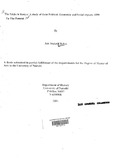| dc.description.abstract | In this study the social, political and economic impact of the Sikhs in Kenya 1890 to the present is addressed. The study aimed at showing the Sikhs’ settlement in Kenya and how they became an important economic force It investigates the determinants ot the Sikhs' race relations, their contribution in education, health and charitable organisation The Sikhs’ political role in colonial Kenya is also investigated.
The research tested the hypothesis, that the Sikhs’ role in nationalists struggle and economic impact transcended racial boundaries, that Sikhism united the Sikhs into an integrated community. And that the Sikh community has undergone transformation in their social and economic life..
The study shows Sikhs’ traditional, religious and situational linkage with the Hindus that resulted in political and economic rivalry with the Indian Muslims in Kenya. The Sikhs’ social institutions, their contribution in sport is brought into focus. The racial colonial structures influenced the Sikhs’ social role and was reflected on economic and political realm.
In view of the above the study recommends an interdisciplinary study of the Sikhs as a-historical and religious community in order to bring to light the continuity and discontinuity between the two fields. The study further recommends studies in Punjabi language as to enable researchers carry out interviews in Punjabi and read immense Punjabi literature.
Though the Sikhs’ economic and political role appeared close to that of other Indians, it was immensely complementary. The Sikhs were in the Police force, they were railway workers, subordinates in the colonial government where they worked as clerks and in the public works department. Others were businessmen. Largely however, Sikhs were fitters, turners, moulders, welders, pattern makers, vulcanisers, plumbers, joiners, cabinet makers, tin smiths, mechanists, wood workers, brick layers, carpenters, masons, bicycle and rikshaw makers, upholsters and painters. The Sikhs economic role was not independent of the colonial or the global economic influences. The study shows that there was a marked correlation between Sikhs economic affluence and their establishment of magnificent temples (Gurudwaras). The study therefore recommends a comparative study of the Sikhs in Kenya and those in developed countries and or those in any other developing state of Africa.
Makhan Singh’s role in the light of the Sikh environment that surrounded his youth and was exhibited in his role as a trade unionist in Kenya is interpreted. The humanistic, anti-racist and military attributes as was evident in his struggle for workers’ liberation is also analysed as an influence of his up-bringing. Makhan Singh’s role, was a deviation of the Sikhs’ politics of bchind-scenes and/or co-operation to open resistance. Thus aligning him to the Sikhs’ militant attributes. The study shows how Sikh's role as exhibited in Makhan Singh’s struggle was a repudiation of discriminatory practices as was instituted by the Sikh Gurus. In line with communism. Makhan Singh opposed ownership of economic affluence at the expense of the workers and attended Gurudwara for only social functions and not religious.
The white settlers' racist struggle for social, economic and political supremacy over :he Indians and the competition over land and political power were addressed. The study analyses the influence of Indias’ separatist politics on the Sikhs’ political role ir Kenya and
how it made them a catalyst in the weakening of Indians’ political unity against the white settlers The Thesis further recommends the study of the Sikhs and other Indians in Kenya. By focusing at differences and similarities and stating reasons in each case. The thesis also recommends to the Government that Sikhs are a distinct religious and historical community with her unique religious rites from the Hindu or the Muslims of Asian origin The global society model as put by Macquet (1971) was a significant guide to the study. As a migrant community the Sikhs had to change to urban life, commerce, trade and professionalism. However they maintained_ their religion and culture, hence they acquired the characteristics of a global society model. The data was collected from the archives, oral sources and from the libraries. The sources were corroborated for authentication of evidence. | en_US |



